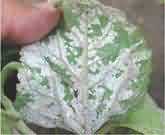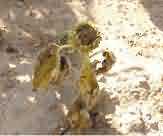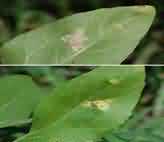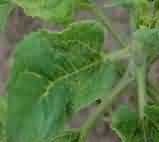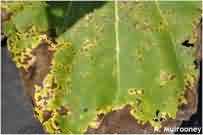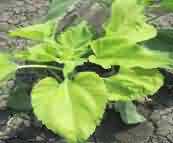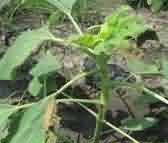सूरजमुखी के 5 प्रमुख रोग और उनका प्रबंधन
Sunflower (Helianthus annuus) belongs to family Compositae. The root system consists of tap root going up to 3 meter depth with larger lateral spread of feeder roots. It is an annual, erect herbaceous plant. Sunflower is grown in India as an ornamental plant since ancient time. But as an oilseed crop, it was introduced in 1969 only. Commercial cultivation of this in India was started in 1972 in few hectares land in southern states. Because of the certain qualities, sunflower becomes popular even in northern states also.
Economic Importance of Sunflower
The favourable features for the phenomenal growth of sunflower in India are, wide adoptability to range of agro climatic conditions and soil types, photoperiod insensitivity overcoming seasonal variations, Short duration (70-100 days), high yield potential of seed and oil, high quality edible oil (high PUFA content), high seed multiplication ratio (>1:80), Easier and cheaper cultivation of the crop (low seed rate, no specialized operations, low water requirement), remunerative market price and non branched determinate plant type with single head.
1. Downy mildew in sunflower: Plasmopara halstedii
Sunflower downy mildew was first described from the North-Eastern United States in the late 19th century on Eupatorium. Sunflower downy mildew can cause heavy losses of up to 50-95 percent in cool wet years.
Sporangiophore is branching at right angle. Pathogen produces oospores which are walled, doubled layered. The pathogen resides in soil as sexually-produced oospores. They are highly resistant to adverse environmental conditions and are capable of remaining dormant in soils for up to 10 years. When soils are saturated and cool, oospores can germinate and form zoosporangia that release motile zoospores that swim through soil water.
New systemic infections occur when zoospores contact and infect seedling roots.
Symptoms
The disease affect on root, basal, stem, leaf & seed. The symptoms are damping-off, systemic infection, local lesion, basal rot or stem gall. Abnormally thick, downward curled leaves and whitish downy growth are developing on lower surface of the leaves (Plate 1).
The flower heads remain sterile and erect (Plate 2). Local foliar lesion symptoms are characterized by small angular greenish yellow spots on leaves (Plate 3). Systemic infection showing chlorotic leaf veins (Plate 4).
Pathogen survives in seed, soil borne through oospores and secondary through wind-borne. Rain during seedling growth favours disease.
Management
Cultural
- Deep summer ploughing
- Clean cultivation and field sanitation
- Avoid excessive irrigation
- Removal of infection plants
Chemical
Seed treatment
- Metalaxyl – 6g/kg seed
Spray treatment
- Redomil MZ 72 WP @ 3g/lit at - 20, 40 and 60 days after sowing.
(Plate 1) (Plate 2) (Plate 3) (Plate 4)
2. Powdery mildew in sunflower: Erysiphe cichoracearum
Powdery mildew caused by Erysiphe cichoracearum has been considered as economically important disease. It affects most of the commercial varieties under present cultivation and it has been reported from different parts of the world.
During the winter the fungus survives on infected plant parts and in debris such as fallen leaves. It may produce resting structures known as cleistothecia, which resist harsh winter conditions. These will appear as small black dots within the white powdery patches.
The next spring, sexual spores (ascospores) are released from the cleistothecia, shot up into the air, and carried by air currents to leaves of plants where new infections will begin. During the growing season, the fungus produces asexual spores (conidia) that help the fungus to spread and infection to build.
Symptoms
White powdery growth is on the leaves (Plate 1). White to grey mildew appears on the upper surface of older leaves. Symptoms are also seen on stem and petiole.
Conditions that favour the host, also favour the pathogen. Spores germinate optimally at 20-25°C under conditions of high humidity, as quickly as two to four hours after landing on the leaf.
Under optimal conditions, infection will lead to the production of more spores within five to seven days. Spores are primarily dispersed by wind. The disease is more under dry condition to the end of the winter months.
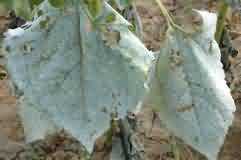
(Plate 1)
Management
Cultural
- Field sanitation
- Early varieties should be preferred
Chemical
Spray treatment
Difenconazole 25 EC @ 1ml/lit at initial stage and 15 days of first spray.
3. Alternaria leaf spot: Alternaria helianthi Hansf.
This disease commonly occurs in all varieties and it rapidly spread during the rainy season. This disease has been reported from different parts of the world including India. Alternaria leaf blight is known to cause more than 80 per cent of yield loss under severe epiphytotic conditions.
Etiology
Causal organism: Alternaria helianthi Hansf.
The conidiophores are cylindrical, scattered or gregarious, pale grey yellow, straight or curved, geniculate, simple or branched, up to 5 septate, 25-80 x 8-11µ. The conidia are cylindrical to long ellipsoid, straight or slightly curved pale grey yellow to pale brown.
Disease cycle
Disease occurs when spores land on leaves or stems, germinate in the presence of free moisture, and directly penetrate and infect the plant. Plants are most susceptible to infection beginning at flowering and continuing through maturity. Plant stress also predisposes plants to the disease. Spores are readily disseminated in and among fields by splashing irrigation water, wind, and perhaps insects. The pathogen survives between sunflower crops in and on infested crop debris, as a pathogen of safflower and cocklebur, and on seed.
Symptoms
- Symptoms appear on leaves, petioles, stem, sepals and petals.
- Symptoms appear as dark brown irregular leaf spots with very dark border and grey centre (Plate 1).
- Spots first appear on lower leaves, later spread to middle and upper leaves.
- At later stages spots may be formed on petioles, stem and ray florets.
- In later stages the leaf lesions may coalesce causing the leaf to wither (Plate 2).
Epidemiology
Wet, warm weather promotes Alternaria disease growth. Regions prone to high humidity and warmer temperatures are susceptible to this disease. Fields that are planted early are susceptible to more severe losses from the affects of the disease than those planted later. Disease development is favoured by 25-27o C temperatures with at least 12 hours of wet foliage.
(Plate 1) (Plate 2)
Management
Cultural control
- Deep summer ploughing
- Clean cultivation and field sanitation
- Use of resistant variety
- Planting on mid-September
Chemical control
Seed treatment
- Carboxyl 75 WP – 2g/kg of seed
- Captan 80 WP – 2g/kg of seed
- Mancozeb 75 WP – 2g/kg of seed
Spray treatment
- Zineb 80 WP – 2g/lit
- Mancozeb 75 WP – 2g/lit
- Hexaconazole 5 EC – 1 ml/lit
Spray at 40, 55 and 65 days of crop.
4. Sunflower Necrosis: Sunflower Necrosis Virus
The disease appeared in epiphytotic form in 1997. Disease was reported from all sunflower growing areas of south India. Disease incidence varied from 0.00 to 100 per cent.
Etiology
The disease transmitted through thrips. Thrips palmi was very well recognized as vector. Thrips recorded on flowers were found to be foraging ones and does not have any role in transmission of the virus disease.
Diseases cycle
Symptoms
- Mosaic and chlorotic ring spot on younger leaf.
- Marginal necrosis of leaf (Plate 1).
- Malformation of ear head.
- Necrosis symptoms on stem and stalk.
- Defoliation of ear head.
- Twisting of stem to S shape (Plate 2).
Epidemiology
Incidence of the disease is moderate (10 to 20%) during Kharif months. It was very low (0 to 5%) during rabi/winter months. It was very high (15 to 100%) during summer months (January onwards).
(Plate 1) (Plate 2)
Management
Cultural control
- Destroy the weeds and other crop plants around the field
- Sowing of jawar , maize or bajra 3 to 4 rows around the field
- Up root infect plant
Chemical control
Seed treatment
- Treat the seeds with Gaucho 70WS @ 4 to 5 g/kg of seeds
Spray treatment
- Confidor 200SL - 0.5ml/l before 20 days and 35 DAS of sowing.
5. Sunflower Rust: Puccinia helianthi
Sunflower rust, caused by the fungus Puccinia helianthi, can cause significant yield and quality losses on susceptible sunflower hybrids under conditions favourable for rust development. P. helianthi has been reported from every state where either cultivated or wild sunflowers are found.
Etiology
Causal organism: Alternaria helianthi
Disease cycle
Sunflower rust completes its entire life cycle on sunflower and can only infect sunflower. Puccinia helianthi overwinters throughout the upper Midwest as black telial pustules on infected sunflower debris. Early season rust infection (aecia) may occur on wild, volunteer or hybrid sunflowers. The aeciospores are then wind-blown to other plants to initiate uredial infections.
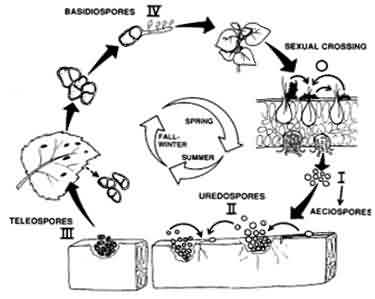
Symptoms
- Small reddish brown spots appear on the lower leaves (Plate 1).
- They slowly spread on all the leaves and green parts of the head.
- The leaves may turn yellow.
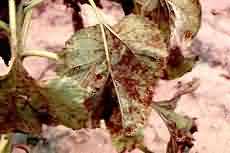
(Plate 1)
Epidemiology
Day temperature of 25.5° to 30.5°C with relative humidity of 86 to 92 per cent enhances intensity of rust attack.
Management
Cultural control
- Crop sanitation
Chemical control
- Zineb 80 WP – 2g/lit
- Mancozeb 75 WP – 2g/lit, Spray 15 days interval of 2 to 3 times.
Authors:
Shantamma1 and Bheemanagouda Patil 2
1Department of Plant Pathology, UAS, GKVK, Bangalore – 560 065, Karnataka
2Department of Plant Pathology, UAS, Raichur – 584 104, Karnataka
Email:

